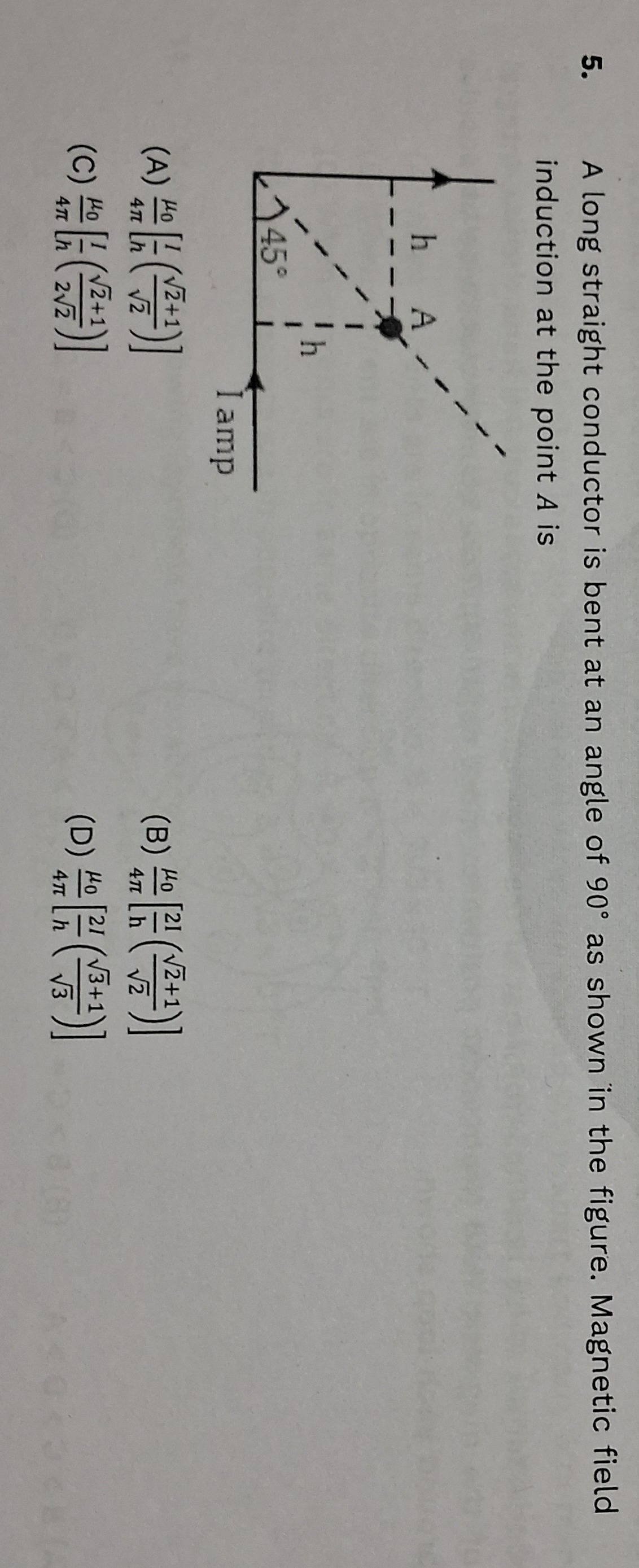Question
Question: A long straight conductor is bent at an angle of 90° as shown in the figure. Magnetic field inductio...
A long straight conductor is bent at an angle of 90° as shown in the figure. Magnetic field induction at the point A is

4πμ0hI[22+1]
4πμ0h2I[22+1]
4πμ0hI[222+1]
4πμ0h2I[33+1]
(B)
Solution
The conductor consists of two semi-infinite straight wires meeting at a 90° angle. We assume the current flows such that the magnetic fields produced by each segment at point A add up, which occurs if point A is in the "inner" region of the bend. Let the corner be at the origin (0,0). Let the horizontal wire extend from (−∞,0) to (0,0) with current in the +x direction, and the vertical wire extend from (0,0) to (0,+∞) with current in the +y direction. For the fields to add up at point A, A must be in the second quadrant, e.g., at (−h,h).
-
Magnetic field due to the horizontal wire (Wire 1): The wire extends from x=−∞ to x=0 along the x-axis, with current I flowing in the +x direction. Point A is at (−h,h). The perpendicular distance from A to Wire 1 is d1=h. The magnetic field due to a semi-infinite wire is given by B=4πdμ0I(sinθ1+sinθ2). Here, θ1 is the angle made by the line joining A to the finite end (0,0) with the perpendicular from A to the wire (at (−h,0)). This angle is 45∘. θ2 is the angle made by the line joining A to the infinite end (−∞,0) with the perpendicular. This angle is 90∘. So, B1=4πhμ0I(sin45∘+sin90∘)=4πhμ0I(21+1). Using the right-hand thumb rule, for current in +x direction and point A above the wire, the magnetic field B1 is directed out of the page.
-
Magnetic field due to the vertical wire (Wire 2): The wire extends from y=0 to y=+∞ along the y-axis, with current I flowing in the +y direction. Point A is at (−h,h). The perpendicular distance from A to Wire 2 is d2=h. θ1 is the angle made by the line joining A to the finite end (0,0) with the perpendicular from A to the wire (at (0,h)). This angle is 45∘. θ2 is the angle made by the line joining A to the infinite end (0,+∞) with the perpendicular. This angle is 90∘. So, B2=4πhμ0I(sin45∘+sin90∘)=4πhμ0I(21+1). Using the right-hand thumb rule, for current in +y direction and point A to the left of the wire, the magnetic field B2 is directed out of the page.
-
Total Magnetic Field: Since both B1 and B2 are in the same direction (out of the page), their magnitudes add up: Bnet=B1+B2=4πhμ0I(21+1)+4πhμ0I(21+1) Bnet=4πhμ0I(2(21+1))=4πhμ0I(22+2) Bnet=4πhμ0I(2+2)=4πμ0h2I(22+1).
